The order corallimorpharia, in the phylum Cnidaria, class Anthozoa, includes anemone-like and coral-like creatures that are very popular in the aquarium hobby due to their hardiness and fantastic range of color and form. Corallimorphs are, as their name implies, very coral-like, but they do not secrete a skeleton. They have radially arranged tentacles or pseudo tentacles, if present. The most popular varieties contain symbiotic zooxanthellae, so their maintenance involves providing sufficient light for photosynthesis by the zooxanthellae. This is not too difficult to achieve for most species, as many of them seem to prefer low light levels or indirect light. Standard fluorescent lights are fine for many, but not all varieties.
Even the symbiotic species feed on a variety of external food sources. All feed on dissolved and particulate matter, some feed on zooplankton, and some even trap and eat fishes! Tiny cilia on the surface of the oral disc help transport trapped dissolved and particulate material to the mouth. Larger prey are trapped by the formation of a sac when the edges of the oral disc fold upwards and meet at a central point. The genera that lack symbiotic zooxanthellae feed actively on large and small prey, mostly zooplankton, using potent nematocysts located on numerous long tentacles.
Reproduction in Corallimorphs is achieved mainly vegetatively (budding, fission, pedal laceration), and the formation of colonies of clones is common for most species. Though it certainly occurs in nature, sexual reproduction involving the release of eggs and sperm by polyps of separate sexes is not well documented. Aquarium observations have so far been of egg release only, and there have not been any reports of new recruits of sexually produced offspring.
Only a few specialists have attempted to classify the corallimorpharia, and the systematics for them is presently incomplete. For example, there is not a clear dividing line between some forms classified as Discosoma and some forms classified as Rhodactis. The two genera seem to merge, and the taxonomist J.C. DEN Hartog tended to group them together as Discosoma, though he still recognized Rhodactis as valid for at least some species.
Discosoma
The common “mushroom anemones” or “Elephant ear mushrooms” or “Disc Anemones” belong to the genus Discosoma. Generally they are disc shaped with a conical mouth, and the oral disc may be smooth, ribbed, with small or large pseudo tentacles or none at all. The edge of the oral disc may form pointed lappets or it may be uniformly circular as if cut by a cookie cutter. The consistency of the tissues is thick and, due to copious mucus production, they are slippery to the touch. They are the hardiest genus for aquarists, and most species thrive even under low light intensities. However, the metallic blue varieties keep their color best under strong illumination. Fluorescent orange and green varieties are spectacular to observe under blue light. Discosoma spp. tolerate strong water flow, but open largest under low velocity water currents. Strong lighting may cause them to curl the oral disc, and even bleach (lose pigment and zooxanthellae). I have been able to reverse this bleaching with the addition of a trace element supplement containing iron and manganese that I found promotes the health of zooxanthellae. My observations in this regard are anecdotal.
The common red, blue, green, brown, spotted, or pinwheel striped Discosoma sp. from Indonesia is a highly variable single species. Some authors have suggested that the different forms are distinct species, but this does not appear to be the case. Single polyps with a combination of features (for example, pinwheel and solid color) occasionally occur, and the range of patterns and colors merge. The presence or absence of vesicles on the oral disc is also highly variable. The identity of this variable species is not known, since its many forms have received different names. The most likely name is Actinodiscus nummiformis, originally described as Discosoma nummiforme in 1828. Discosoma fowleri, described in 1888 may be the same species. A second species from Indonesia has more distinctly defined lappets at the perimeter of the oral disc and is slightly smaller in maximum size, see photos. Both species live principally on the photosynthetic products of their symbiotic zooxanthellae, and they supplement this with dissolved organic food absorbed from the water, and particulate matter trapped in mucus and carried by cilia to the mouth. I have seen some specimens envelop and eat flake food or blackworms, but only in situations where they occur in very low water velocity. They close up very slowly and water currents tend to blow food out of their “grasp.” The Indo-Pacific Discosoma spp. rapidly reproduce by pedal laceration, budding, and transverse fission.
The two Discosoma spp. from the Caribbean have been collected and imported recently from Haiti in sufficient numbers that they have now become readily available to hobbyists. Discosoma neglecta, the umbrella corallimorph, is a spectacular polyp with pronounced tongue-like lappets. It achieves a maximum diameter of about 15 cm and is typically bright fluorescent green, brown, or a combination of the two. Rare specimens are orange or turquoise. Discosoma neglecta feeds readily on chunks of shrimp or fish, and also takes pellet food or flake food. Discosoma carlgreni is closely related, and the two may sometimes hybridize, confusing the distinction between them. Discosoma carlgreni has more numerous and smaller lappets at the margin of the disc, and it has more numerous pseudotentacles. These pseudotentacles are also branched in large specimens, whereas in Discosoma neglecta the pseudotentacles are more lobe-like. Both Caribbean species of Discosoma reproduce in aquaria by budding and pedal laceration, but in my experience colonies grow much more slowly than Indo-Pacific Discosoma, even when they are fed regularly.

Discosoma ( = Actinodiscus ) nummiformis blue form from Indonesia. To keep this bright blue color they require strong illumination.
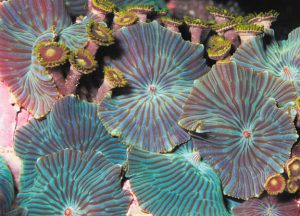
Discosoma ( = Actinodiscus ) nummiformis blue pinstripe form from Indonesia. These don’t require as much light as the solid blue form.
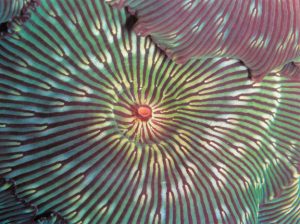
Discosoma ( = Actinodiscus ) nummiformis green pinstripe form from Indonesia. These fluoresce brilliantly under blue light.

Discosoma ( = Actinodiscus ) nummiformis Red form from Indonesia. These fluoresce brilliantly under blue or green light.
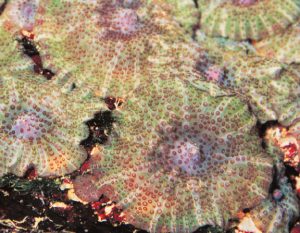
Discosoma sp. from Indonesia. The vesicles on the oral discs of this colony are reminiscent of the tentacles of Ricordea spp.
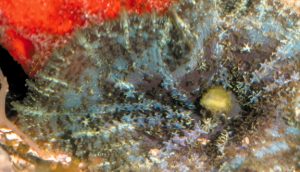
Discosoma carlgreni from Florida and the Caribbean. Note branched Pseudotentacles on the oral disc and the numerous small lappets at the disc margin. D. carlgreni are usually turquoise, but occasionally are orange.

Discosoma neglecta photographed at Riverbanks Zoo and Aquarium. This six inch diameter specimen shows the typical elongated lappets on the disc margin.
Rhodactis
Rhodactis spp. have an oral disc covered with pseudotentacles that are usually branched. The edge of the oral disc in most species has toe-like tentacles, and there is often a naked tentacle-free margin separating the central oral disc from the edge of the disc. Some species have thick tissues, but many have rather thin tissues, much thinner than in typical Discosoma. Most are also slippery to the touch. Rhodactis spp., except R. cf. mussoides actively feed on fleshy food when it is offered, folding up the disc margins to envelop the food. The tentacled varieties of Rhodactis spp. tolerate and prefer much stronger light and water motion than most Discosoma spp. Large species of Rhodactis can trap fishes, in the same manner as the related genus Amplexidiscus. Rhodactis spp. reproduce by fission, pedal laceration, and a type of budding that involves the formation of gemmules both internally and on the surface of the oral disc (Sprung and Delbeek, 1997).
From Indonesia there are many varieties of Rhodactis, whereas the Caribbean has just one species, R. sanctithomae, also known as Discosoma sanctithomae. It has branched pseudotentacles and a naked region next to the disc margin. Occasionally the pseudotentacles are not branched, being grape- like vesicles instead. This form once was given a different name, Orinia torpida. Rhodactis sanctithomae feeds on zooplankton and takes all kinds of protein rich foods offered. It prefers strong illumination, but should be oriented vertically on rocks or walls, not facing the light directly.
Rhodactis inchoata from the Indo-Pacific has thicker tissues than many other Rhodactis spp., and it is often very colorful. The disc margin has toe-like tentacles. The purple Tonga mushroom is R. inchoata, and there are distinctive multicolored green, blue, and red specimens imported from Indonesia. It does not require supplemental feeding and does not feed as readily as other species in the genus.
Two other forms of Rhodactis imported from Indonesia include the “Giant Green Metallic Mushroom,” which is an undescribed species, and another undescribed species that has pseudopolyps that mimic the polyps of the coral Goniopora. The former species grows to over 30cm in diameter, while the latter grows to about 20 cm. The former readily feeds on chopped shrimp or pellet foods, and grows to enormous size under fluorescent lighting. An additional species, tentatively identified as Rhodactis mussoides, has very thick tissues like the mussid stony coral Lobophyllia. It is rather like a Discosoma, lacking tentacles at the disc margin, but it can have multiple mouths like a mussid coral and like Ricordea florida. It prefers indirect light. Blue actinic bulbs promote the development of green fluorescent protein in this species, and specimens maintained under blue light become intensely green.

A colony of Rhodactis sp. in the Solomon Islands. Such densely packed colonies are produced by pedal laceration and fission.
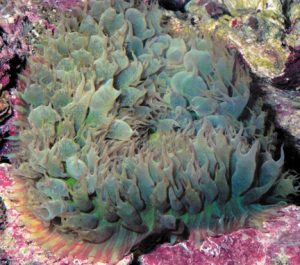
Rodactis sanctithomae from Florida and the Caribbean is a delicate species, with thin tissues that are easily torn. It should be fed frequently to encourage it to grow and divide, and it prefers strong indirect light.
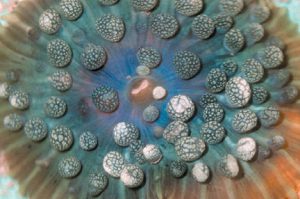
Rhodactis sanctithomae sometimes forms rounded vesicles on the oral disc. This form was once described as a distinct species.
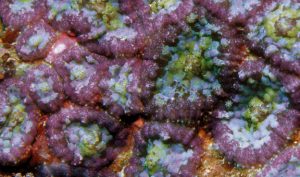
The purple Tonga mushroom, Rhodactis inchoata, comes in numerous color combinations that sometimes blend surprisingly well with live rock.

This exceptionally large colony of Amplexidiscus fenestrafer was photographed on a reef slope in the Solomon Islands. Normally this corallimorph occurs in groups of four or five polyps. For size reference, each large polyp is approximately 10 inches in diameter.
Amplexidiscus
Amplexidiscus appears like an extremely large Rhodactis, but it is distinguished by some features of its nematocysts. It also grows slightly larger than most Rhodacits spp., with a maximum diameter of approximately 20 inches (50 cm). Amplexidiscus fenestrafer is the only species recognized in the genus, though there may be a second species according to a researcher named Chen (Charles Delbeek, pers. comm.). Amplexidiscus fenestrafer is a piscivore, and it apparently uses an attracting and intoxicating scent to lure fishes into the folds of its oral disc. It slowly closes around the fish until it has trapped it within the sac formed, and then it digests the fish with mesenterial filaments. In the aquarium Amplexidiscus fenestrafer can trap fishes, but it can also be maintained and fed dead fish. Most fish learn to avoid it, but there is always a risk that Amplexidiscus fenestrafer will trap and eat your favorite fish. Reproduction in A. fenestrafer is typically by pedal laceration or budding, but fission is occasional.
Ricordea
Ricordea spp. have vesicle-like tentacles on the oral disc. While some species of Discosoma and Rhodactis may develop vesicles on the oral disc, there is no mistaking them with the pronounced tentacles of Ricordea. One look-alike that can be confused with Ricordea is Stichodactyla tapetum (Sprung, 2001). The latter has sticky tentacles while the former does not. Both can form colonies of numerous individual polyps approximately 5 cm in diameter. Both reproduce by fission. Stichodactlya tapetum also has a form that may grow to 30 cm in diameter. The maximum size for Ricordea is about 15 cm in diameter. There are two widely recognized species of Ricordea, R. florida from the Atlantic and Caribbean, and R. yuma from the Indo-Pacific region. Both are very popular in the aquarium trade. Ricordea yuma is readily distinguished from R. florida by the fact that the former has pseudotentacles on the oral cone, while the latter does not. Also, R. florida often has numerous mouths and elongated irregular polyps, while R. yuma is usually circular, with one mouth. All are spectacular due to the grape-like tentacles on their oral disc, but some especially prized specimens have brilliant fluorescent proteins in shades of orange, red, pink, blue, and green.
Pat Gibbs and his students at the University of Miami have been able to isolate the genetic material that produces these colors in Ricordea, and put it into the freshwater zebrafish, Danio rerio. Under blue light they fluoresce brilliant green, orange, or blue, like the Ricordea polyps from which the pigments were derived.
Ricordea spp. prefer moderate currents and moderate to strong illumination. They may reject some foods offered, but they will take live blackworms. Some specimens reproduce slowly, while others do so more quickly, given the same conditions. The rate of reproduction is thus apparently genetically determined (Pat Gibbs, pers. comm.).

Even plainly colored specimens of Ricordea yuma are beautiful. This solitary specimen was photographed in deep water in the Solomon Islands, along with a commensal Periclimenes shrimp.
Corynactis
Corynactis spp. are mainly temperate species, known as Strawberry anemones. They are small, not usually larger than one inch (2.5 cm) in diameter, and colonial, reproducing by fission and pedal laceration to cover large areas of rocks. Tropical species may occasionally be introduced to aquariums with live rock. The tropical species are less colorful, tend to be cryptic, and form much less densely packed colonies. All Corynactis spp. feed on zooplankton and particulate organic matter. To keep them healthy and encourage division, they need to be fed at least several times per week. A “milkshake” of chopped seafood can be used, but they will also take flake or pelletized foods, and frozen shrimp or worms.
Pseudocorynactis
Pseudocorynactis spp. are like Corynactis but are much larger (to about six inches (15 cm) diameter, and usually not colonial. They also reproduce by fission, but it is unusual to find more than about six clones together as a group. The so-called orange ball anemones that can be observed on coral reefs at night are Pseudocorynactis spp. The column varies in color from cryptic shades of brown to orange, red and magenta. The tips of the tentacles are commonly bright orange, but they can also be white. These tentacle tips are extremely sticky, like flypaper, due to the presence of powerful nematocysts. This fact makes the larger species from the Indo Pacific region unsuitable for aquariums housing fishes, which they readily capture. They also can catch mobile invertebrates such as shrimps and snails, and sometimes “attack” sessile invertebrates growing on adjacent rocks, enveloping them in the gastric cavity through a widely opened mouth. Pseudocorynactis spp. can be fed daily, but only require twice weekly feeding to keep them healthy. If they are not fed frequently enough, they shrink. There is a marked behavioral difference between the common Caribbean and Indo-Pacific species.
The Caribbean species, Pseudocorynactis caribbaeorum mainly opens its tentacles at night, and closes rapidly when it senses light. The Indo-Pacific species remains open both day and night, and is not sensitive to light. The presence of food smells (dissolved amino acids) in the water stimulates either species to open up and extend the tentacles, and the caribbean species can be trained to open in the light by feeding it during daylight hours. The mechanism for its apparent memory is not known.
Whether you have a large reef aquarium or a simple small aquarium, any of the corallimorphs can be easily maintained and enjoyed for decades.
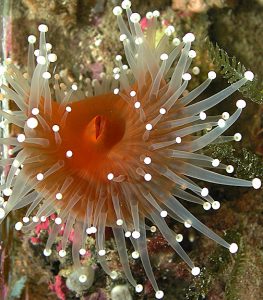
This Pseudocorynactis from Fiji is beautiful but not safe with fishes and adjacent invertebrates. It is a voracious eater that has powerful nematocysts in the ball-like tentacle tips.
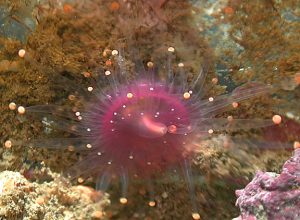
The expanded polyp of Pseudocorynactis caribbeorum. Note the orange ball- like tentacle tips for which the Orange Ball Anemone is named.
Suggested Reading
- Carlgren, O. 1949. A Survey of the Ptychodactaria, Corallimorpharia and Actiniaria. Kungl. Sven. Vetenskapsakad. Handlingar, Ferde Ser., 1, 1-121 + 4 plates.
- Dunn, D.F. and Hamner, W. M. 1980. Amplexidiscus fenestrafer n. gen., n. sp. (Coelenterata, Anthozoa), a tropical Indo-Pacific corallimorpharian. Micronesica, 16, 29-36.
- Hartog, J.C. DEN 1980. Caribbean Shallow Water Corallimorpharia. Zoologische Verhandelingen. 176:1-83.
- Schlichter, D., Bajorat, K.H., Buck, M., Eckes, P., Gutknecht, D., Kraus, P., Krisch, H., and Schmitz, B. 1987. Epidermal nutrition of sea anemones by absorption of organic compounds dissolved in the oceans. Zool. Beitr. N.F., 30, 29-47.
- Sprung, J and J.C. Delbeek 1997 The Reef Aquarium Volume Two Ricordea Publishing
- Sprung J. 2001. Invertebrates: A Quick Reference Guide. Ricordea Publishing
- Information about research in fluorescent proteins at the University of Miami’s Rosenstiel School of Marine and Atmospheric Sciences can be found at the following URL: www.rsmas.miami.edu/groups/niehs/science/models.jsp#zebra
- The Hexacorallians of the World Database: http://www.kgs.ukans.edu/Hexacoral/Biodata/index.html



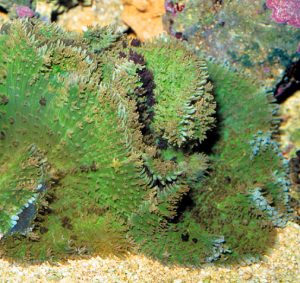
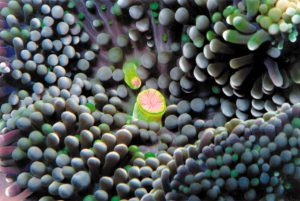
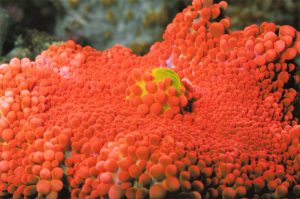

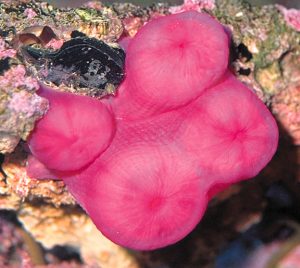

0 Comments